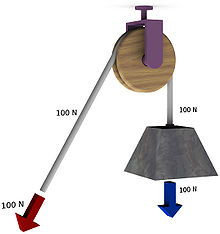مقره
Appearance
Ottoman Turkish
[edit]
Alternative forms
[edit]Etymology
[edit]Vulgarized form of earlier بكره (bekre), which was borrowed from Arabic بَكَرَة (bakara, “pulley, block”). For the change of initial consonant /b/ > /m/, compare منتشه (menteşe, “hinge”), منكشه (menekşe, “violet”) and میان (mıyan, “licorice”).
Noun
[edit]مقره • (makara) (definite accusative مقرهیی (makarayı), plural مقرهلر (makaralar))
- pulley, block, one of the simple machines consisting of a wheel with a grooved rim
- Synonym: منجور (mencur)
- bobbin, a spool or cylinder around which wires, threads, cables, or ropes are coiled
Derived terms
[edit]- مقره ایپی (makara ipi, “pulley rope”)
- مقره دلی (makara dili, “sheave of a block”)
- مقره زوانهسی (makara zıvanası, “axle of a pulley”)
- مقره صپانی (makara sapanı, “strop of a pulley”)
- مقره كبی جرلامق (makara gibi cırlamak, “to chat”, literally “to squeak like a pulley”)
- مقرهجی (makaracı, “maker or seller of pulleys”)
- مقرهلو (makaralı, “furnished with pulleys”)
- چاتی مقره (çatı makara, “chevron”)
Descendants
[edit]- Turkish: makara
- → Albanian: makara
- → Armenian: մախարա (maxara)
- → Cypriot Arabic: mpakara
- → Macedonian: макара (makara)
- → Romanian: macara
Further reading
[edit]- Barbier de Meynard, Charles (1886) “مقره”, in Dictionnaire turc-français, volume II, Paris: E. Leroux, page 779
- Çağbayır, Yaşar (2007) “makara”, in Ötüken Türkçe Sözlük (in Turkish), volume 1, Istanbul: Ötüken Neşriyat, page 3026
- Hindoglu, Artin (1838) “مقره”, in Hazine-i lûgat ou dictionnaire abrégé turc-français[1], Vienna: F. Beck, page 455a
- Kélékian, Diran (1911) “مقره”, in Dictionnaire turc-français[2], Constantinople: Mihran, page 1209
- Moran, Ahmet Vahid (1924) “pulley”, in A condensed dictionary, English–Turkish, Constantinople: Fratelli Haim, page 437b
- Nişanyan, Sevan (2002–) “makara”, in Nişanyan Sözlük
- Redhouse, James W. (1890) “مقره”, in A Turkish and English Lexicon[3], Constantinople: A. H. Boyajian, page 1944
